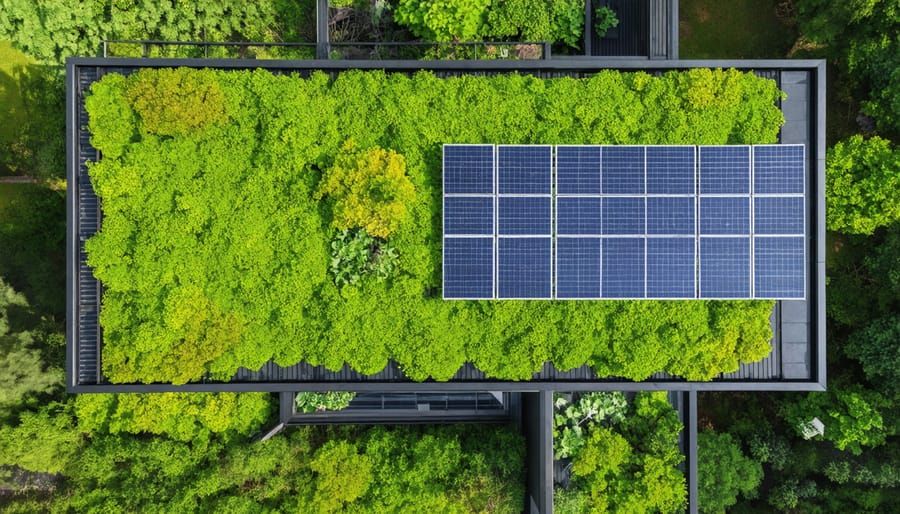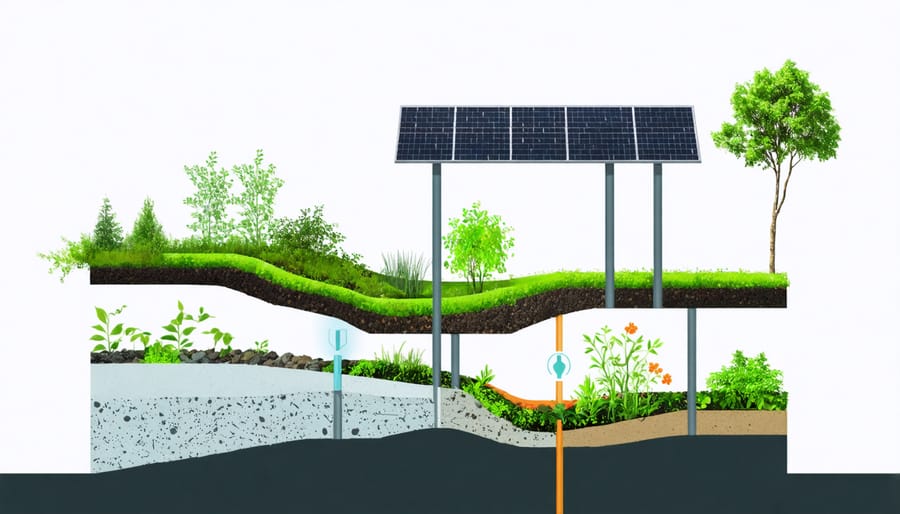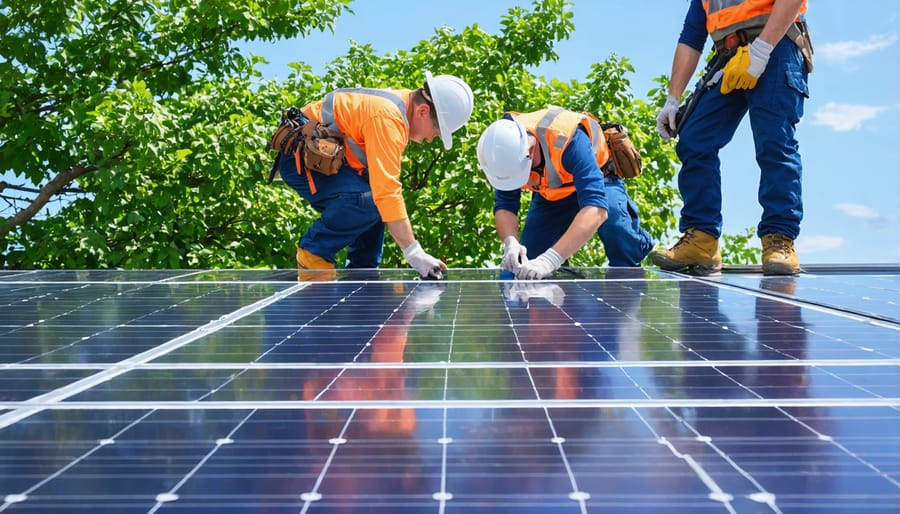Solar-Powered Green Roofs: The Future of Sustainable Urban Living

Transform your home’s environmental impact while boosting property value with a residential green roof system – a living, breathing ecosystem that seamlessly integrates with modern sustainable architecture. As Europe’s solar potential in Europe continues to expand, combining vegetation layers with photovoltaic installations creates powerful synergies that enhance both technologies’ performance.
Green roofs reduce urban heat islands, manage stormwater runoff, and create vital biodiversity hotspots while providing natural insulation that can cut energy costs by up to 30%. For homeowners navigating Europe’s stringent building regulations, these systems offer a sophisticated solution that aligns with EU climate targets while delivering tangible benefits – from extended roof membrane lifespans to improved air quality.
Modern residential green roof designs range from lightweight extensive systems requiring minimal maintenance to intensive rooftop gardens that transform unused space into vibrant living areas. With advancing technology and growing installer networks across Europe, implementing these sustainable solutions has never been more accessible or economically viable for homeowners committed to environmental stewardship.
Understanding Solar-Enhanced Green Roofs
The Synergy Between Solar Panels and Green Vegetation
The combination of solar panels and green roofs creates a remarkable synergy that enhances the performance of both systems. When integrated with urban green infrastructure, solar panels benefit from the cooling effect of surrounding vegetation, which can increase their efficiency by up to 8%. The plants maintain lower ambient temperatures through evapotranspiration, preventing the panels from overheating during peak summer months.
Conversely, the partial shade created by solar panels helps protect vegetation from excessive sun exposure and reduces water evaporation from the soil. This microclimate creates diverse growing conditions, allowing for a wider variety of plant species to thrive. The panels also serve as natural rainfall distributors, helping to spread water more evenly across the green roof surface.
Modern mounting systems enable solar installations to be secured without compromising the roof’s waterproofing or plant growth. The spacing between panels can be optimized to ensure sufficient sunlight reaches the vegetation while maximizing energy generation. This dual-purpose approach not only maximizes rooftop utilization but also contributes to building energy efficiency and biodiversity, making it an increasingly popular choice among European property owners committed to sustainable development.

Key Components and System Integration
A residential green roof system comprises several critical layers that work together to support both vegetation and solar installations. The foundation begins with a high-quality waterproofing membrane, protecting the building structure from moisture. Above this lies a root barrier layer, preventing plant roots from compromising the waterproofing system.
The drainage layer, typically made of specialized materials like expanded clay or recycled plastic modules, manages excess water while ensuring proper aeration. This is followed by a filter fabric that prevents soil particles from clogging the drainage system. The growing medium, specifically engineered for roof applications, provides essential nutrients while maintaining a lightweight profile.
For solar integration, mounting systems are carefully positioned to distribute weight evenly across the roof structure. Modern solutions include ballasted frames that don’t penetrate the waterproofing layers, ensuring system integrity. The vegetation selection focuses on low-maintenance species that complement solar panel efficiency by providing natural cooling effects.
Smart monitoring systems track both plant health and solar performance, while integrated irrigation solutions ensure optimal moisture levels. The entire system requires professional installation to ensure proper load distribution and seamless integration of all components, maintaining both environmental benefits and energy generation capacity.
Benefits for European Homeowners
Energy Production and Cost Savings
Green roofs significantly contribute to energy efficiency and cost savings in residential buildings through multiple mechanisms. During summer months, the vegetation and substrate layers act as natural insulators, reducing indoor temperatures by 3-7°C and lowering air conditioning demands by up to 75%. In winter, these same layers provide additional insulation, decreasing heating requirements by 10-30%.
Studies across European cities demonstrate that residential green roofs can reduce annual energy consumption by 15-45%, depending on the building’s characteristics and local climate. For a typical 150m² residential roof, homeowners can expect to save between €300-800 annually on energy bills.
The longevity of green roofs also generates substantial cost benefits. Traditional roofing materials typically require replacement every 15-20 years, while properly maintained green roofs can last 40-50 years. This extended lifespan translates to significant long-term savings, with maintenance costs offset by reduced energy expenses.
Moreover, many European countries offer financial incentives for green roof installation. Germany, for instance, provides subsidies covering up to 50% of installation costs in certain regions. Combined with increased property values (typically 7-15% higher for buildings with green roofs) and potential stormwater management fee reductions, the return on investment period typically ranges from 5-10 years, making green roofs an economically viable solution for residential properties.

Environmental Impact and Building Efficiency
Residential green roofs deliver significant environmental benefits while enhancing building performance through natural insulation. These living roof systems form an integral part of modern sustainable energy systems, reducing urban heat island effects and managing stormwater runoff effectively. Studies across European cities demonstrate that green roofs can reduce building energy consumption by 15-30% annually through improved thermal regulation.
The vegetation layer acts as a natural air purifier, capturing airborne pollutants and CO2 while releasing oxygen into the atmosphere. A typical 150m² green roof can capture approximately 100kg of CO2 annually and filter thousands of particles of air pollution. Additionally, these installations create vital urban habitats for local wildlife, particularly beneficial insects and birds, contributing to urban biodiversity.
From a building efficiency perspective, green roofs extend roof membrane life by protecting it from UV radiation and temperature fluctuations. They also provide excellent acoustic insulation, reducing sound transmission by up to 40 decibels, making them particularly valuable in noise-sensitive urban environments. This combination of environmental benefits and improved building performance makes green roofs an increasingly attractive option for sustainable urban development.
Property Value Enhancement
Installing a green roof can significantly boost your property’s market value, with European real estate studies indicating an average increase of 7-15% compared to conventional roofing systems. This enhancement stems from multiple factors, including improved energy efficiency, extended roof lifespan, and enhanced aesthetic appeal. Properties with green roofs often command premium prices in urban areas where green spaces are limited.
The market appeal extends beyond mere monetary value. Modern homebuyers increasingly prioritize sustainable features, making green roofs a compelling selling point. In cities like Copenhagen, Amsterdam, and Berlin, where environmental consciousness is high, properties with green roofs typically sell faster than conventional alternatives.
Furthermore, many European municipalities offer tax incentives and reduced stormwater fees for buildings with green roofs, creating long-term financial benefits. Insurance companies often provide better rates due to the protective qualities of green roofs, while utility companies may offer additional incentives for reduced energy consumption. These combined financial advantages, coupled with the visual appeal and environmental benefits, make green roofs an increasingly attractive investment for property owners looking to enhance their real estate value while contributing to urban sustainability.
Installation and Maintenance Considerations
Structural Requirements and Planning
Before installing a green roof, a thorough structural assessment is essential to ensure your building can support the additional weight. A fully saturated green roof system typically adds 60-200 kg per square meter, depending on the type of installation. European building regulations require professional evaluation of load-bearing capacity, which should be conducted by a qualified structural engineer.
The underlying roof structure must be in excellent condition with proper waterproofing and drainage systems. Key components include a high-quality waterproof membrane, root barrier, drainage layer, filter fabric, and growing medium. The roof’s slope should typically be between 1° and 30°, though specific requirements vary by region and system type.
Planning should account for access points for maintenance, irrigation systems, and safety features required by local building codes. In many European countries, fall protection systems are mandatory for maintenance access. The building’s existing drainage capacity must also be evaluated and potentially upgraded to handle increased water retention.
Climate considerations play a crucial role in planning. Areas with heavy snowfall require additional structural support, while regions with high winds may need specialized anchoring systems. It’s also important to consider the building’s orientation and shadow patterns when selecting plant species and planning layout.
Early consultation with green roof specialists and local authorities ensures compliance with building regulations and helps optimize the system’s long-term performance.

Long-term Care and Monitoring
Successful green roof systems require dedicated long-term maintenance and regular monitoring to ensure optimal performance and longevity. A comprehensive maintenance schedule typically includes quarterly inspections of drainage systems, vegetation health assessment, and structural integrity checks. During these inspections, professionals evaluate plant coverage, remove unwanted vegetation, and assess the growing medium’s condition.
Water management plays a crucial role in long-term care. Irrigation systems need regular calibration, especially during establishment periods and drought seasons. Modern sensor systems can help monitor moisture levels and automatically adjust watering schedules, improving efficiency and plant survival rates.
Fertilisation requirements vary by season and plant selection, but generally, slow-release organic fertilisers are applied annually in spring. Soil testing should be conducted every two years to maintain optimal growing conditions and adjust nutrient levels accordingly.
Winter preparation is essential in European climates. This includes trimming certain plants, clearing drainage paths, and ensuring protection against frost damage. Professional maintenance teams should document all interventions and system performance metrics, creating a valuable database for future optimisation.
For maximum sustainability, integrate maintenance protocols with other building systems. This includes coordinating with solar panel cleaning schedules and ensuring maintenance activities don’t compromise other rooftop installations. Regular system monitoring helps identify potential issues early, preventing costly repairs and extending the green roof’s lifespan.
European Regulations and Support
Current Legislative Framework
The regulatory landscape for residential green roofs across Europe has evolved significantly in recent years, with many countries implementing supportive legislation. Germany leads the way with its comprehensive green roof policies, requiring vegetation on new buildings in many municipalities. France has introduced legislation mandating either solar panels or green roofs on all new commercial buildings, while Denmark and the Netherlands offer substantial incentives for residential green roof installations.
In the UK, local authorities increasingly include green roof requirements in their planning policies, particularly in urban areas. Many European cities provide financial incentives, including tax breaks and direct subsidies, to encourage homeowners to install green roofs. These initiatives typically cover 30-60% of installation costs.
Building standards for green roofs are primarily governed by European norm EN 16941-2, which outlines technical requirements for rainwater harvesting systems. Additionally, the European Federation of Green Roof Associations (EFB) has established guidelines for best practices in green roof construction and maintenance.
For residential installations, homeowners must typically obtain planning permission and ensure compliance with local building regulations, particularly concerning structural load capacity and drainage systems. Many jurisdictions also require professional certification of installers to qualify for incentive programs.
Financial Incentives and Programs
Many European countries and municipalities offer attractive financial incentives to promote the adoption of green roofs in residential settings. Property owners can benefit from direct subsidies, tax reductions, and specialized financing programs that make installation more affordable. For instance, Germany leads with subsidies covering up to 50% of installation costs in several cities, while cities like Copenhagen provide grants of up to €40 per square meter for green roof projects combined with solar energy solutions.
Local authorities often integrate green roof incentives within broader sustainability programs, offering additional benefits when combined with other eco-friendly improvements. These may include expedited permit processes, increased building density allowances, or reduced stormwater fees. Some municipalities provide technical assistance and planning support through dedicated green infrastructure offices.
Financial institutions across Europe have developed specialized “green mortgages” and low-interest loans specifically for sustainable building improvements. These programs typically offer preferential terms for projects that include green roofs, recognizing their long-term value and environmental benefits. Property owners should consult their local environmental agencies and financial advisors to explore available incentives, as programs and eligibility criteria vary by region and are regularly updated to reflect new sustainability goals.
The integration of solar panels with green roofs represents a significant leap forward in sustainable urban development, offering a powerful solution to multiple environmental challenges. By combining these technologies, property owners can maximize their roof space while contributing to climate resilience and energy independence. The evidence is clear: solar-enhanced green roofs deliver superior environmental benefits compared to traditional roofing systems or standalone green roofs.
As European cities continue to face increasing pressure from climate change and urbanization, the adoption of these hybrid systems becomes more crucial than ever. The demonstrated benefits – from improved energy efficiency and biodiversity support to enhanced stormwater management and reduced urban heat island effect – make a compelling case for wider implementation across residential and commercial properties.
The time to act is now. Property owners, developers, and municipalities across Europe have the opportunity to lead the way in sustainable urban development by embracing this innovative approach. With available incentives, technical support, and growing expertise in installation and maintenance, the barriers to adoption are lower than ever before.
By investing in solar-enhanced green roofs today, we not only enhance our properties’ value and performance but also contribute to creating more resilient, sustainable cities for future generations. The technology is proven, the benefits are clear, and the support systems are in place – all that remains is for more property owners to take this important step toward a greener urban future.
Leave a Reply